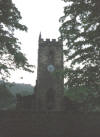Whilst the Hobson name occurs frequently in various Yorkshire
records, the branch of the family that has so far been identified as having a
direct connection with the Fretwells came from the Dodworth area. Now an outer
suburb of Barnsley, Dodworth has a long history as a small village, with
settlement being recorded at least as early as 1090 when it was granted to the
Monastery of St John by the Norman Ilbert de Lacy. Its viability over the
centuries was variously assured by the ironstone mines, timber resources,
tanning, farming, linen weaving and coal.
John Hobson
The main focus here is on John Hobson. The date of John's
birth has not been confirmed, but he was the grandson, on the one side, of
William Fretwell of Herringthorpe (Bramley) and Dorothy Pashley who were married
at Braithwell in September 1651, and, on the other, of John Hobson (1620-1705)
and Elizabeth Prince(ss) of Woolley. His parents were Helen, the second child, and only
daughter, of William and Dorothy, and a son of John and Elizabeth Hobson, also
called John. A memorial to his forebears is referred to in his diary. After the
death of his mother, a marble monument was brought from Wakefield and placed
inside the Silkstone church on 3 May 1731 by one Josia Hawkesworth, presumably a
local mason.
 This
branch of the Hobson family were of sufficient standing to merit a mention in
the publications "The Making of Barnsley" [1]
and “Aspects of Barnsley” I[2].
From these we learn that the Hobsons were long standing members of the Dodworth
community, and that their principal living came from tanning, a business still
carried out by John the Diarist. By the fifteenth century there were four
tanyards in Dodworth and the village, together with Cawthorne, was a major
centre of the industry. The buildings in the photograph to the left[3]
of is part of what is known locally as the Tanyard - exactly the area where Mr
Hobson would have had the main part of his business.
This
branch of the Hobson family were of sufficient standing to merit a mention in
the publications "The Making of Barnsley" [1]
and “Aspects of Barnsley” I[2].
From these we learn that the Hobsons were long standing members of the Dodworth
community, and that their principal living came from tanning, a business still
carried out by John the Diarist. By the fifteenth century there were four
tanyards in Dodworth and the village, together with Cawthorne, was a major
centre of the industry. The buildings in the photograph to the left[3]
of is part of what is known locally as the Tanyard - exactly the area where Mr
Hobson would have had the main part of his business.
The Hobsons were also considerable landholders. In 1540, when
the Crown sought to raise revenue by selling off monastic lands, the Hobsons
were part of the syndicate of local people who took advantage of the sale.
Indeed, the Hobsons were one of the more influential families of Dodworth until
at least the mid 1700s.
 John, a gentleman tanner, was a sociable man, which enabled
him to keep up-to-date with all the "goings-on" - essential for a man
in business. His Diary attests to a busy
schedule of travel around and beyond his immediate district on matters business
and pleasurable. In today's terms, he clearly saw the value of networking. The
diary contains a wealth of references to
friends, acquaintances, and other notables of the time. John had at least one
sister, and one brother, William, and, as far as is known, never married. From
the Diary it would seem that his unnamed sister lived with him (also unmarried)
and William, in the distilling business, resided in London.
John, a gentleman tanner, was a sociable man, which enabled
him to keep up-to-date with all the "goings-on" - essential for a man
in business. His Diary attests to a busy
schedule of travel around and beyond his immediate district on matters business
and pleasurable. In today's terms, he clearly saw the value of networking. The
diary contains a wealth of references to
friends, acquaintances, and other notables of the time. John had at least one
sister, and one brother, William, and, as far as is known, never married. From
the Diary it would seem that his unnamed sister lived with him (also unmarried)
and William, in the distilling business, resided in London.
A
preoccupation with the state of his health in the later Diary entries indicates
that John was in failing health towards the end of his life. He was buried, as
were his ancestors, at Silkstone[4]
on 15 May 1735. Dodworth, despite its prime location on a major trade route west
out of Barnsley, was ecclesiastically within the parish of Silkstone until the
building of its first church in 1846.

[1] The
Making of Barnsley, Brian Elliot
Wharncliffe Publishing Limited, Barnsley, 1988 ISBN: 0 9507892 6 7
[2] Aspects
of Barnsley
Wharncliffe Publishing Limited, Barnsley, 1993, ISBN 1 871647 19 3
[3] Courtesy
Peter Hamby
[4] Photograph
of Silkstone Church courtesy Mollie Muncie
